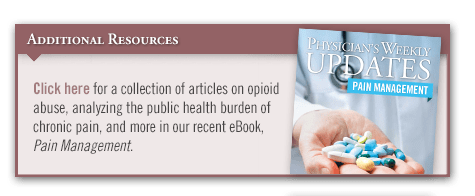According to current estimates, more than 76 million people in the United States suffer from chronic or acute pain. Opioid analgesics are a widely accepted treatment for severe acute pain, but use of these medications to treat some types of chronic pain remains controversial. “The challenge with chronic pain is that it can occur in the context of numerous diseases and syndromes,” explains Daniel J. Castillo, MD. “The problems associated with opioid use—including underprescribing, overprescribing, tolerance, dependence, and drug abuse—highlight the importance of safe opioid use in hospitals and other healthcare settings.”
Research has shown that pain is a leading cause of disability and can have deleterious effects on ability to work, functional status, and other quality-of-life domains. Unalleviated pain can impair the immune response, impede wound healing, affect gastrointestinal and pulmonary functions, suppress appetite, and delay ambulation after surgery. The number of opioid prescriptions for pain management has increased substantially over the last 20 years, in part due to a growing consensus that opioids are appropriate for some patients with pain. At the same time, there has been an increase in prescription opioid misuse and associated mortality, affecting adolescents and adults of all ages.

A Sentinel Event Alert issued by the Joint Commission in 2012 provides a number of actions that can be taken by hospitals to avoid the unintended consequences of opioid use among hospital inpatients (Table 1). It also provides clinicians with strategies for avoiding accidental opioid overuse (Table 2). “Opioids can be helpful for some patients, but it’s important that clinicians recognize and understand that there are risks to consider,” Dr. Castillo says.
Joint Commission Standards On Pain Management
In 2001, the Joint Commission released pain management standards for accredited ambulatory care facilities, behavioral healthcare organizations, critical access hospitals, hospitals, and other institutions. “The Joint Commission’s standards require patients to be assessed for pain, and if they are experiencing pain, then it should be managed,” says Dr. Castillo. The standards do not require the use of drugs to manage pain. When a drug is appropriate, the standards do not specify which drug should be prescribed.
“The goal is to urge all patients to take a role in preventing healthcare errors by becoming active, involved, and informed participants in their health care.”
“We acknowledge there have been some misunderstandings of the Joint Commission’s pain management standards,” says Dr. Castillo. “A key part of these standards is that they allow providers to use their clinical judgment to determine the best course of treatment for their patients.”
Getting Patients to Speak Up
Recently, the Joint Commission released “Speak Up: About Your Pain,” an engaging animated video intended for patients that illustrates reasons why it is important for them to speak up about their pain. The multimedia experience provides patients with easy-to-understand examples of describing different kinds of pain. Examples include aching, throbbing, dull, and shooting pain, as well as cramping. In the
video, patients can learn how to tame their pain by speaking up and describing their conditions to healthcare providers.
According to Dr. Castillo, the Speak Up campaign can be a helpful tool for clinicians to connect with patients who are living with pain. Patients are encouraged to:
• Make sure their pain is assessed by a healthcare provider.
• Describe the pain they are experiencing to their caregivers.
• Take appropriate steps to alleviate pain.
• Ask their healthcare provider about alternative pain treatments if medications they are currently taking cause side effects.
• Inquire about methods other than medication for treating their pain, such as physical therapy, acupuncture, or massage therapy.
The “Speak Up: About Your Pain” video is the eighth installment of the Speak Up video series from the Joint Commission. Previous videos have emphasized the importance of speaking up and asking questions about preventing infections, medication safety, preparing for office appointments, and other important aspects of healthcare.
“This is a tool that your office can use to educate patients and enhance physician–patient dialogue,” says Dr. Castillo. “The goal is to urge all patients to take a role in preventing healthcare errors by becoming active, involved, and informed participants in their health-care.” For information from the Joint Commission on pain management, visit www.jointcommission.org. The website also allows users to access free downloadable files of all the Speak Up videos, brochures, and posters—including Spanish language versions—to provide to their patients.



 admin
admin